|
This post created by ignored player and thus hidden.
Double click to show.
|
|
|
No matter how detailed the descriptions, some people need to see examples before things click. Here are some examples on how to weed your garden without guesswork. You will find times you have to guess, but the less you do, the better off you'll be. Step One: clear out the single islands: 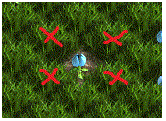
No two groups can touch each other, so since this is a group of 1, all of the sides must be roads. Step Two: clear out spots between groups: 
Again, no two groups can touch each other, so the spot between them must be a road. Step Three: clear out corner groups: 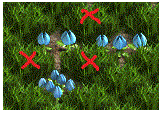
All of these spots can be cleared because if any of the groups went to them they would touch another group. Step Four: clear out edges where the road must travel. 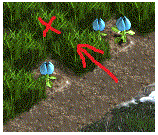
Because of Step Two we know that the spot between these two groups must be a road. All roads must connect to each other, and the only way this road can go is to the X, so you know it can be cleared. Step Six: clear other obvious places the road must go: 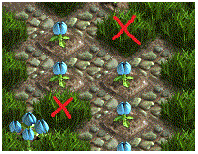
Both of these spots can be cleared because the roads are boxed in from the groups of single flowers. After doing all of the above you will have a LOT of your garden already cleared. The following posts will show you where to go from here. |
|
|
|
|
This post created by ignored player and thus hidden.
Double click to show.
|
|
|
Next, look for isolated groups of 2 flower rows: 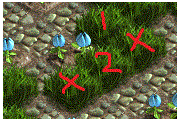
This group must either go towards box 1 or 2. Since it can't go past that, the other two blocks can be cleared: 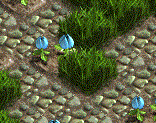
This now opens up a corner. Corners tell you where a row must go. No 2x2 square can be all roads, one must be a flower: 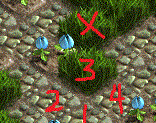
Block 3 must be a flower because the others are roads. This tells us that the X can be cleared since 3 finishes the two flower row, and no other flowers can touch it: 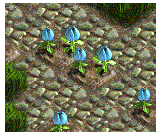
3 row flowers will often have a corner telling you where to go, too: 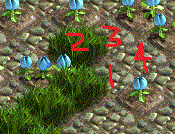
Block 2 must be a flower because it's a corner, forming the second block of this three block row. There is only one direction this row can go now to make a group of three, and X can be cleared: 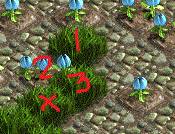
|
|
|
|
|
This post created by ignored player and thus hidden.
Double click to show.
|
|
|
Using an unfinished row to complete a different row: 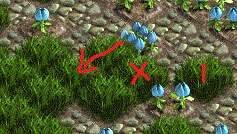
Here we see a 6 block row that we know must travel along the arrow. As it does it clears X because we can't have rows touching. This then shows that block 1 is the flower to complete the 2 block row. Another nice result of this is that we now know both of the blocks along the arrow are flowers because it has nowhere else to go. Using row limits to reveal roads: 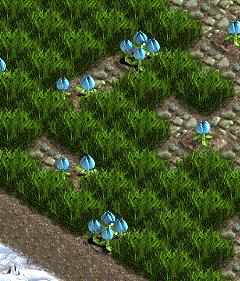
In the middle of the picture we see a group of blocks that can be revealed due to where the flower blocks around them can potentially go: 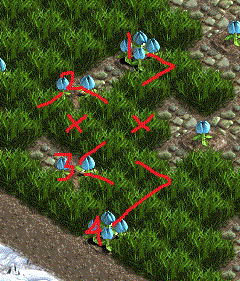
Row 1 gets stopped because going farther would connect it to row 2. Rows 2 and 3 can each potentially go in both directions shown, and Row 4 can go to its' limit of four flowers as shown. This leaves 2 blocks that none of the rows can reach, and can therefor be weeded. Another example of row limits revealing roads: 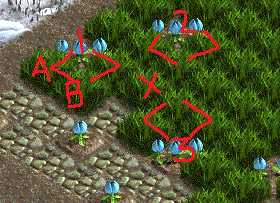
Row 1 is the key here. Either Block A or B (or both) must be a flower to avoid a 2x2 square block of roads. This limits the potential of Row 1. Rows 2 and 3 could move in either of the shown paths leaving X as unreachable by any of the three and so safely weeded. Using the same area to get another block revealed: 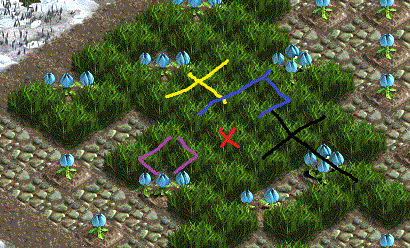
While this seems like a lot of work to reveal a single bit of road, roads are the key to success. Because all roads must connect, finding a block in the middle of things like this will eventually give you the clue to how the flower rows have to actually go. |
|
|
|
|
This post created by ignored player and thus hidden.
Double click to show.
|
|
|
Using road requirements to reveal rows: 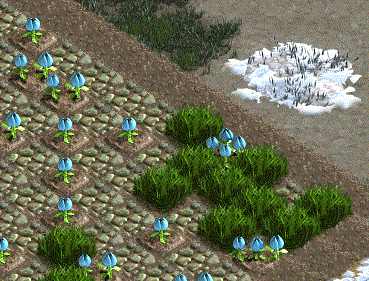
We're going to focus on the 4 block row to begin with. There is a corner spot it must reach, using up 3 spots: 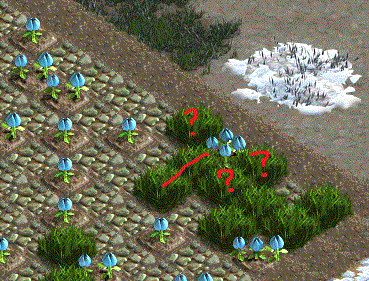
To the northwest is a road that has no exit yet, so X must be a road: 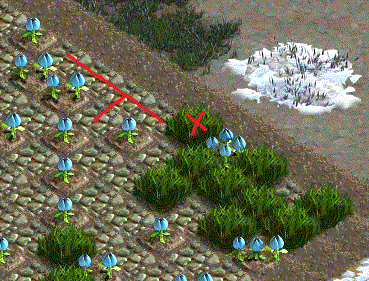
This now leaves two potential spots for the 4 block row to go. Roads 1 and 2 must also be completed, and they will solve both of the rows in the process: 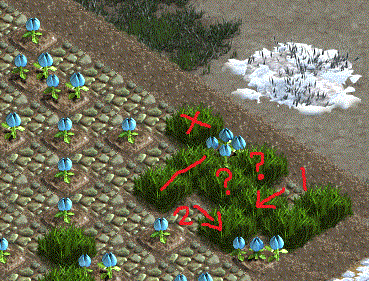
Road 2 must follow the arrow because it is the only way it can connect to the rest of the roads. Road 1 therefor must follow its' arrow because going any other direction would force the 3 block row into a form that would block it off from the rest of the roads. The result of these moves reveals the corner for the final spot in the 4 block row: 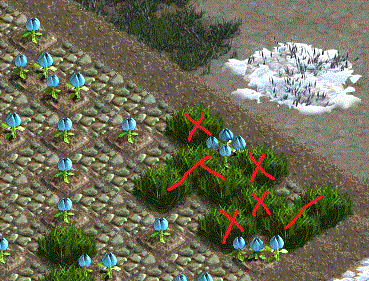
|
|
|
|
|
This post created by ignored player and thus hidden.
Double click to show.
|
|
|
Advanced road limitations: 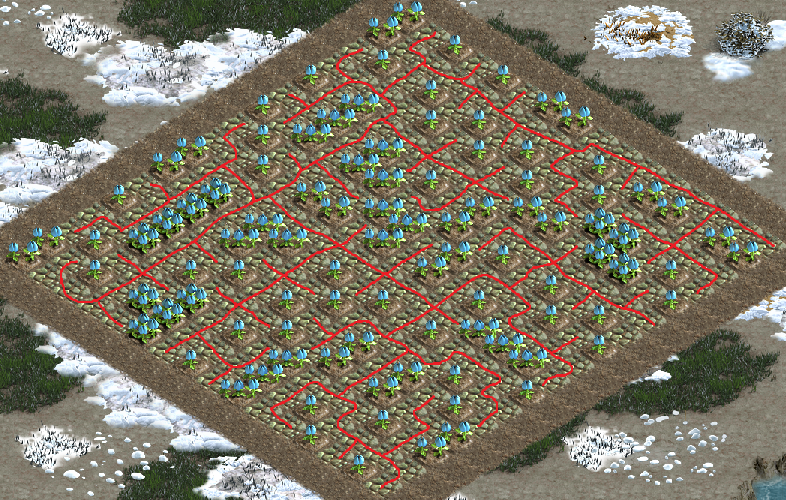
Sorry for the large picture, but it's needed. If you follow any of the roads (highlighted red to make it easier) you will see that they all form branches, but no branch will form a loop. While this will not show us flower spots frequently it will show them occasionally to avoid having to guess: 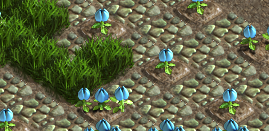
Here we are trying to figure out where the third block of the 3 block row must be. The single flower row can use this technique to tell us: 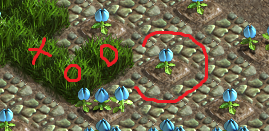
Since a road cannot make a loop the road around the 1 flower row shows us that the remaining weed must have flowers in it, and that tells us where the 3 flower row must go. A more complex example: 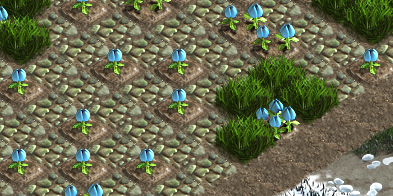
Here we are trying to eliminate guessing on the 4 flower row, at this point we only know of 1 because of the corner spot, but this rule will reveal another: 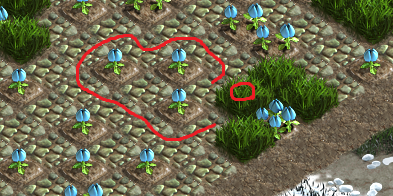
This technique is most easily used when you are nearing the end of a garden, and will not always show you a solution, but any time you can avoid guessing the better odds you will have of finishing the garden! |
|
|
|
|
This post created by ignored player and thus hidden.
Double click to show.
|
|
|
Thank you so much for taking the time to do this. I am a visual learner and it makes it much easier to understand, Well done:) |
|
|
|
|
This post created by ignored player and thus hidden.
Double click to show.
|
|
|
Nice guide, have added the link to it into the guide index. |
|
|
|
|
This post created by ignored player and thus hidden.
Double click to show.
|
|
|
This is amazing. Great work. |
|
|
|
|
This post created by ignored player and thus hidden.
Double click to show.
|
|
|
Fantastic guide, Donimoes! Thanks so much for this! However, I did recently read about another rule (in here http://www.totemtribe.com/talk/my-first-9-flower-row/ that paths can't form a loop, but they have to connect like branches on a tree. That rule has often solved seemingly unsolvable choices for me. Maybe you could include that in your guide, too?
Edited 15 hours, 15 minutes later by berserker.
Reason: fixed link.
|
|
|
|
|
This post created by ignored player and thus hidden.
Double click to show.
|
|
|
Hmm. I had been seeing this as a theory, not a rule. Nurikabe does not list this as a rule, but after rereading the post you linked to, I see a statement from Bers: "Nice observation. While this is not really a rule, but a level generator
side effect, it is quite consistent so I guess I can post it as a rule
to the Florist explanations." Unless Bers comes here and says he's tweaking the generator to enable a perfect circle I will screenshot the next one I see and add it in to the guide. Thanks! |
|
|
|
|
This post created by ignored player and thus hidden.
Double click to show.
|
|
|
I've added that rule in the florist explanation in the latest updates so it is official now. |
|
|
|
|
This post created by ignored player and thus hidden.
Double click to show.
|
|
|
Thank you for this. I am also a visual learner. Mil gracias.
Edited 10 minutes later by berserker.
Reason: don't overquote.
|
|
|
|
|
This post created by ignored player and thus hidden.
Double click to show.
|
|
|
Actually, if I'm not mistaken, we know all 4 blocks with flowers in your last example, then: 12 34X The reason for that is: 1. : the loop rule as you already explained 4.: is already revealed 3.: because a cluster of 4 roads is prohibited 2.: as number 4 couldn't be reached by road, as the block to the right of number 4 would keep the road from reaching flower block number 4. As far as I remember, there is a rule that ALL flower blocks must have contact to a block with a road. -> X must be a road PROBLEM SOLVED! :)) |
|
|
|
|
This post created by ignored player and thus hidden.
Double click to show.
|
|
|
You are right and wrong, #2 ended up being the final road. Yes, the example shown was actually solvable with the more basic road requirements rule if I had shown a bigger picture. It's not often that the loop rule is the only way to solve a cluster, that example was used purely to show a larger loop being formed. Good observation though! :) Not all flower blocks must touch a road though. Here is an example: 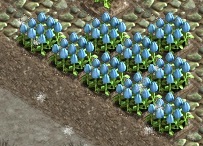
|
|
|
|
|
This post created by ignored player and thus hidden.
Double click to show.
|
|
|
Oh...Okay I never had such a massive block of flowers before, that's why I presumed that all of them had to be touched by road. Now I can forget about that. :( Oh well, back to guessing...at least sometimes. |
|
|
|
|
This post created by ignored player and thus hidden.
Double click to show.
|
|
|
When you are dealing with large flower rows it can be easy to assume a corner spot is part of a smaller row. Try to clear out more of an area or use row limitations to verify spots like these: 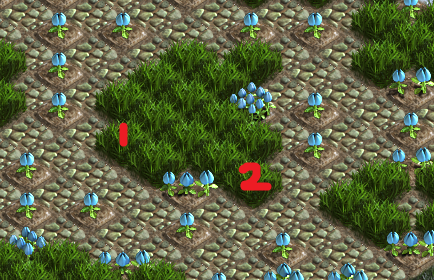
When I first came across corner 1 I almost made the mistake of assuming it was part of the 3 flower row. Luckily I noticed the 9 flower row could also reach that spot so continued clearing until I came across corner 2, showing the direction the 3 flower row actually goes. |
|
|
|
|
This post created by ignored player and thus hidden.
Double click to show.
|
|
|
When you are dealing with large flower rows it can be easy to assume a corner spot is part of a smaller row. Try to clear out more of an area or use row limitations to verify spots like these: 
When I first came across corner 1 I almost made the mistake of assuming it was part of the 3 flower row. Luckily I noticed the 9 flower row could also reach that spot so continued clearing until I came across corner 2, showing the direction the 3 flower row actually goes.
@Donimoes -- don't suppose you have a uncovered version of that pic? not sure how i would solve that entirely--- just picking up on the non-loop rule!! that kills me everytime!! thanks for that reveal =) this is an awesome guide...hopefully i can get somewhere with my darn garden now lol |
|
|
|
|
This post created by ignored player and thus hidden.
Double click to show.
|
|
|
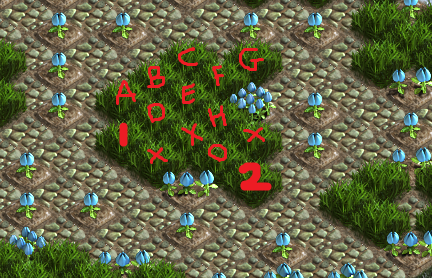
The X's must be roads to avoid connecting the 9 and 3 block rows. C must be a flower because it's a corner. G must be a flower because it's a corner. D must be a flower to connect to 1. F must be a flower to connect to G. H must be a flower or it would form a loop, visualize the X's being gone, it would loop down below the 3 flower row. A or B (or both) must be a flower to avoid having a 4 block road. This leaves 2 flowers for three potential blocks, A B E. If both A and B are flowers E is a road that is blocked. Therefore the remaining two spots are either A and E or B and E. Unfortunately you would have to either guess or use a herbicide on either A or B to determine the correct solution. |
|
|
|
|
This post created by ignored player and thus hidden.
Double click to show.
|
|
|
If more of the garden has been cleared, it might be possible to rule out
'A' as road, as it might form a bigger loop in the northern section outside that fragment... sometimes the clue to determine between 2 (or more) seemingly valid choices for certain block may be at the other end of the garden... |
|
|
|
|
This post created by ignored player and thus hidden.
Double click to show.
|
|
|
Amazing job. Should have come here sooner, would have saved a lot of frustration. Thanks for this. |
|
|
|































